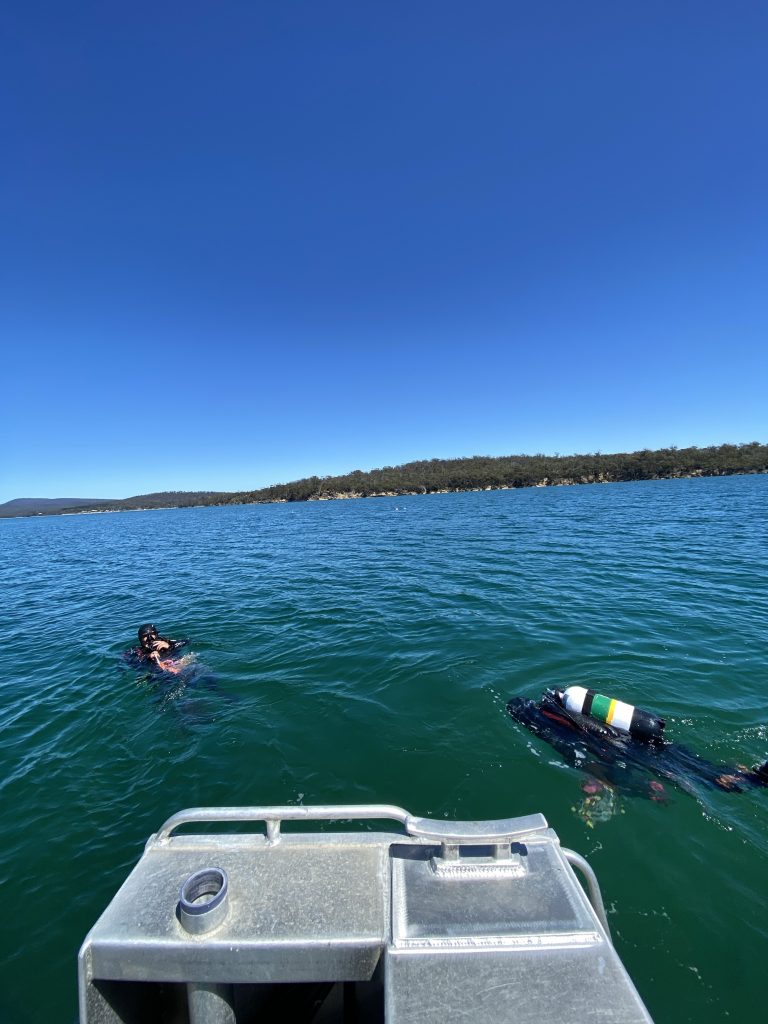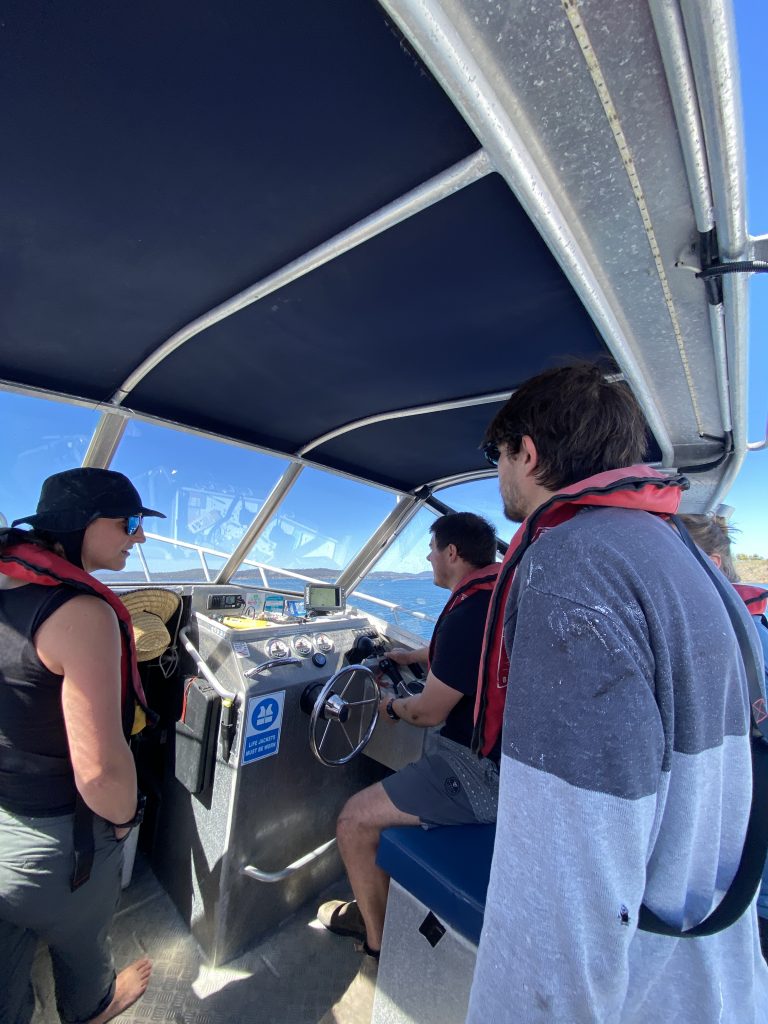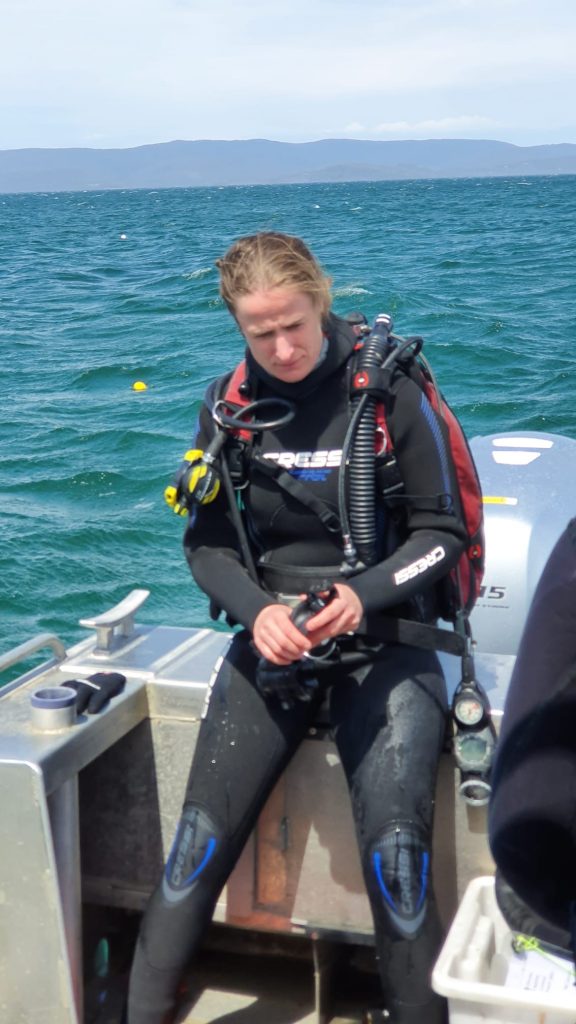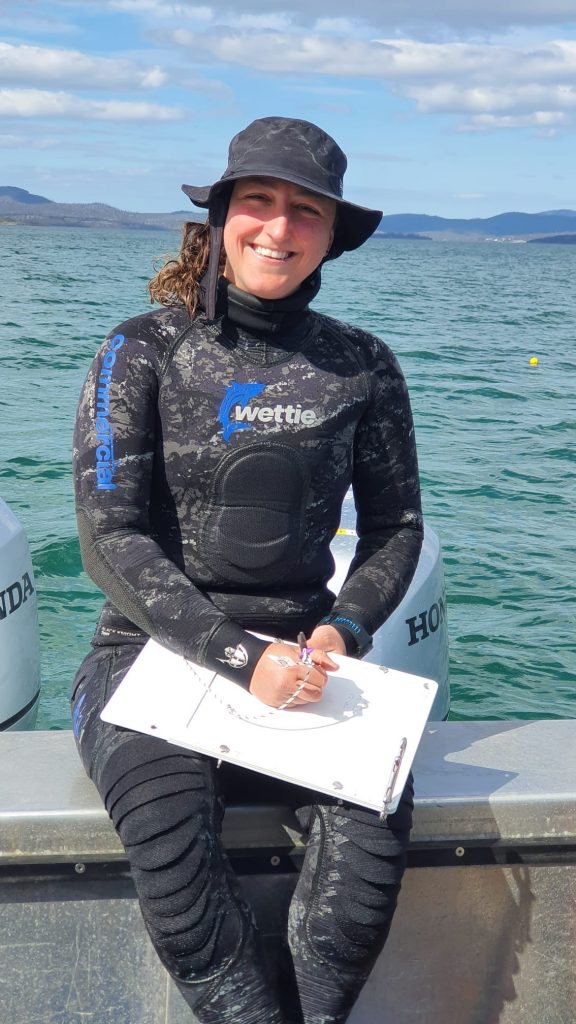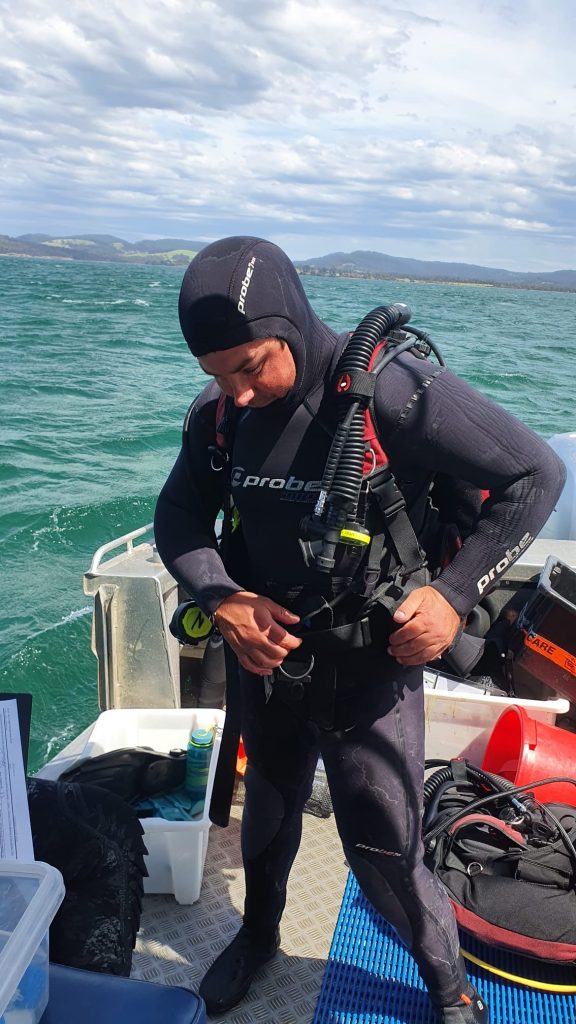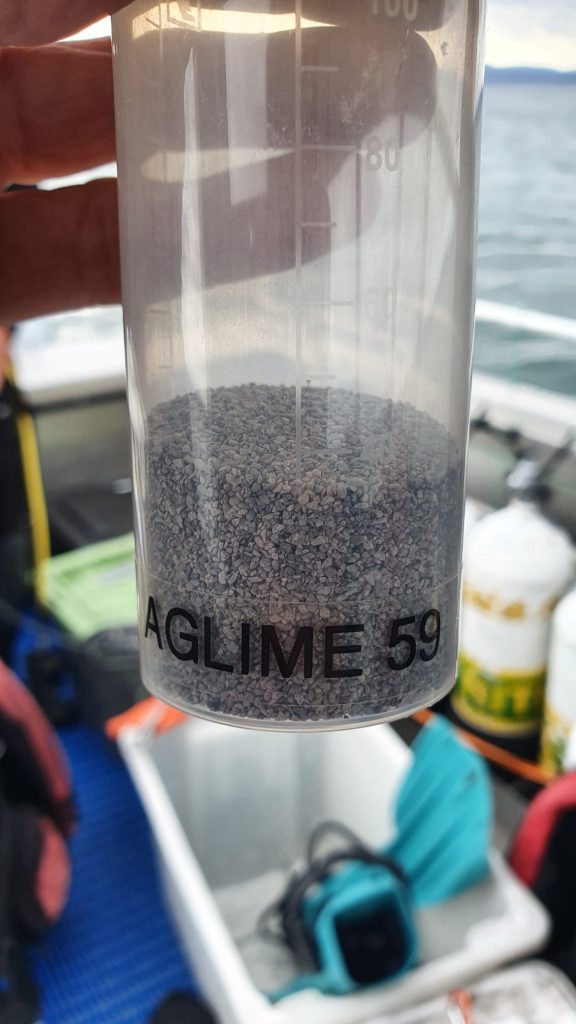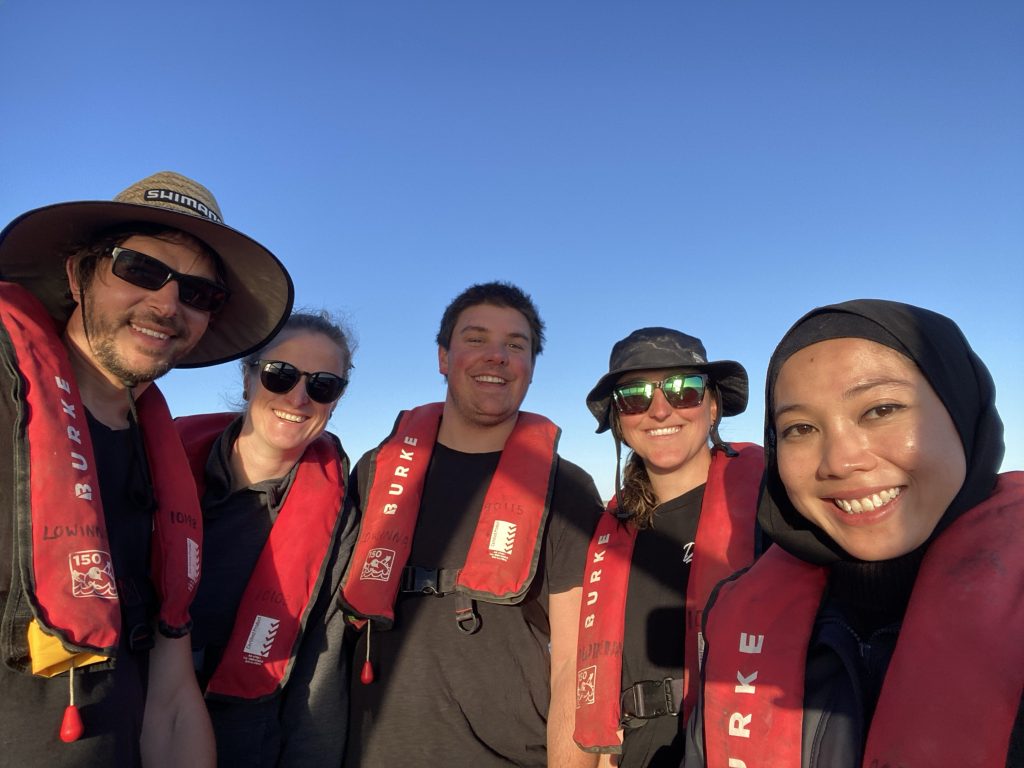Our main goal on days 4-7 (1.11.2024, 46.11.2024) was to get the alkaline minerals on ~1.5 m2 plots on the seafloor and get our first samples. We decided to set up 12 plots in total. Four plots serve as untreated controls, four plots were enriched with agricultural lime (Ag-lime) sourced from a quarry in Mole Creek (Tasmania) and four with dunite (olivine) sourced from Mortlake (Victoria). On Friday (1.11.2024), we went out to set up the remaining plots (we had set up 8 of 12 so far) and created an underwater map of the study site. One of the most difficult aspects of the underwater sampling is to navigate through the underwater landscape and find the different plots. Everything looks more or less the same on these sediments and navigating between 12 plots on a 25 by 25 m field at a visibility of 4 m requires a compass and reliable mapping. This takes a lot of time! We also tested how to deploy Ag-lime underwater, and our assumption was that it would behave the same as the dunite powder that we had tested before. But this assumption was wrong. The Ag-lime powder was just blown away with the currents, surprisingly different to what we had seen before from the dunite despite the density not being that different. This meant we had to do a weekend shift to figure out the best grain size and we weighed in roughly 4 kg in small vials to have enough for the 4 plots.
On Monday (4.11.2024), we went out super early as we knew it would be a loooong day distributing the two different minerals on the 8 plots and setting up baseline measurements. On site, Damon and Marianne got straight into to the water to add the Ag-Lime onto the plots. For homogeneous distribution of the powder across the plot we sub gridded the plot into 16 smaller squares and added one vial with mineral per square. Afterwards they added the dunite powder with the same approach. However, we did only two plots per dive to keep the delivery time at a feasible minimum since we were concerned that secondary precipitation may happen in the vials (the vials containing the dunite powder had to be filled with seawater before diving because otherwise they would float up). It therefore took quite a bit longer than the Ag-lime delivery. Once the minerals were on the plots, there was still some time left to deploy benthic flux chambers. These are used to investigate in our case alkalinity fluxes out of (and into) sediments. The tricky part here was that the batteries are heavy and had to be slowly lowered to the seafloor from the boat as the divers could not carry them. There was quite a sea breeze on us by then, so this did not make things easier. Nevertheless, we managed to get them down safe and soundly and their deployment worked a treat! (Thanks Brad Eyre for lending them to us, we handle them with great care!). The last task of the day was to distribute dunite powder with particle tracer in separate and much smaller plots to assess the practical use of particulate tracer for monitoring, reporting and verification (as in Alex Milde’s manuscript: https://www.authorea.com/doi/full/10.22541/au.172910556.66443041/v1). Marianne is leading this part of the study, and she build the most beautiful mini sediment cores and box for them 😉 The deployment of the tracer-enriched dunite plus the first sampling with mini-sediment cores was the last task for the day. Back at the boat ramp around 6, back in Hobart around 8, SCUBA tanks filled around 9, pizza eaten around 10, in bed around 11.
On Tuesday (5.11.2024), we aimed to take the first set of pore water samples from each plot. However, the day started really badly because one of the wheel hubs of the boat trailer blew on the way from Hobart to the boat ramp. Luckily, it was just at the end of the drive and close to the boat ramp so we could remove the tyre, limb to the boat ramp and get the boat into the water. The boating officers at IMAS did a great job of helping us out and come down all the way from Hobart to repair the wheel hub while we were on the water (thanks Dave and Sam!). This whole drama cut 4 hours out of the schedule so that we arrived on site only 11 am. In the water, Marianne, Damon, and Nadine took 3 sets of pore water samples per plot (each set consists of 5 samples taken from a sediment depth between 0 and 7.5 cm). As expected, this took quite a while, so we “only” managed to do 3 of the 4 replicates per treatment (control) before darkness. The remaining replicate would have to be done on the next day. On surface, we measured pH and took alkalinity samples from the pore water samples. As the wind had picked up and created quite a chop it was challenging to get those 135 samples processed. And because there was only an aluminium box to sit on it was painful to the bottom (literally). On a good note, the last samples could be measured once everyone was on the boat and we could move to a somewhat sheltered bay close by with less chop. This eased off the sea sickness before transfer back to the boat ramp.
On Wednesday (6.11.2024), we aimed to get the remaining pore water samples, get sediment cores for benthic in fauna (the worms, creepy crawlers etc. living in the sediments), and recover the benthic flux chambers. The original plan was to sample the flux chambers every day for three days in the morning and evening but due to the wheel hub drama on the previous day we had to dismiss this idea and instead just do one 48 hour incubation. Since the repair on the boat trailer (previous day) was just a temporary fix we could not do any long drives with the trailer anymore and therefore had to launch the boat off a boat ramp much closer to our homebase and do a longer boat drive instead. We launched out of the lagoon at Cremorne which meant we had to pass Frederick Henry Bay which is exposed to the south to the open Southern Ocean. Not so much an issue in the morning as the wind was north but it was meant to turn south for the afternoon… The transfer went well (in fact much faster than the days before), so we could start working on site at around 9:30 to get the remaining pore water samples. Next task were the cores, which the divers took, and the boat team pulled up to process on board via sieving them. We took 8 cores from around the plots as a baseline, which took quite a while. When we take cores from the plot, we will have to do 36 on a day…looking forward to that. Last was the recovery of the benthic flux chambers 48 hours after their deployment. Nothing exciting in the pH data but let’s see what the alkalinity data shows. After another solid dive session, we went off back toward Cremorne. The wind had swung from North to South and was much beyond 20 knots, which created a solid wind swell in Frederick Henry Bay, making the drive home a wilder one.
Back at the home base everyone was quite happy that these 3 massive days were over. Despite many unforeseen challenges more than 50% of what we wanted to do worked well, which is the benchmark for success in field work. Big shoutout to everyone for their hard work and Damon for great leadership in this study.
Thanks for reading and more soon…
Lennart Bach

